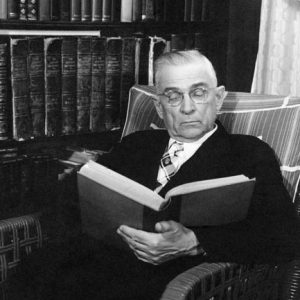calsfoundation@cals.org
Cromwell Architects Engineers, Inc.
Cromwell Architects Engineers is one of the oldest architectural firms in the nation and is clearly the oldest in Arkansas. Begun in 1885 with one architect and his draftsman son, by the twenty-first century, the firm had more than 100 employees offering a variety of services and could show an enormous body of completed work around the world. Most notably, the firm employed Charles Louis Thompson (1868–1959) and his son-in-law, Edwin Boykin Cromwell (1909–2001), both of whom were well known in their profession.
The firm’s history begins with the arrival in Little Rock (Pulaski County) of Benjamin J. Bartlett. It is likely that both he and his son came to the state because they had been selected in 1885 to design the Arkansas School for the Blind, which in its day was a very substantial project. They were soon selected for additional projects. In 1886, Charles Thompson, a seventeen-year-old draftsman from Danville, Illinois, answered Bartlett’s advertisement in a lumber journal. Bartlett recognized the talent of his new draftsman, and the firm became Bartlett and Thompson within two years. Bartlett moved to Mississippi in 1890, where he was retained for the design of a county courthouse. He withdrew from the firm, and twenty-one-year-old Thompson was on his own. The Little Rock City Directory of 1890 ran his advertisement: “Charles L. Thompson, Architect and Superintendent.”
The following year, Thompson joined forces with Canadian-born civil engineer Fred Rickon and began a very productive relationship. In the 1895 promotional piece “A New Years Greeting,” Rickon and Thompson listed forty-five buildings they had designed, twenty-four of which were in Little Rock. The two men dissolved their partnership in 1897, however, and Thompson went the next nineteen years without a business partner, although there were a number of talented employees, beginning with Thomas Harding Jr., son of the well-known Arkansas architect of the late nineteenth century, who was hired in 1898 at the age of fourteen. Like Thompson himself, Harding acquired most of his education through experience, reading, and correspondence courses. By 1916, the firm had completed hundreds of buildings, and Thompson invited him to be his partner that year. The firm name became Thompson and Harding.
Several other architects were brought into the firm in the early years of the twentieth century. One was Theo Sanders, who had studied architecture at the University of Illinois between 1898 and 1902 and then spent a year at the Ecole des Beaux Arts in Paris, arguably the leading design school in the world. Another was Frank Ginocchio, whom Thompson put on the staff supervising the construction of the Arkansas State Capitol. After World War I, Sanders and Ginocchio created their own firm, but the firm Thompson Sanders and Ginocchio was established in 1927.
Thompson retired in 1938. Sanders and Ginocchio continued on until Sanders withdrew. At that time, Edwin Boykin Cromwell, who came to Arkansas as an architect with the Resettlement Administration, was invited into the firm to succeed Sanders. Ginocchio and Cromwell divided the office duties: Cromwell assumed the responsibility for the “inside work”—design, drafting, and business management—while Ginocchio stayed with construction supervision. The pair designed the Arkansas Governor’s Mansion, which opened in 1950. The mansion was built on the original site of the Arkansas School for the Blind, which was razed in 1939.
The firm prospered under Cromwell’s leadership. The late 1940s to the 1970s constituted a period of growth. In 1954, engineering services in addition to architecture began to be offered, with key engineers including Ben Dees, Oliver Gatchell, and Bill Woodsmall. Eugene P. Levy joined the firm in 1962 and later became its CEO. Other key leaders added to the team were Ray Parker and J. Brent Thompson.
In 1965, Cromwell gained its first overseas work, constructing the U.S. consul’s residence and staff housing in India. Innovative work was done by the firm at the Mississippi County Community College in 1975, using a solar design with photovoltaic cells. Work at the Little Rock Air Force Base led to other contracts with the U.S. Department of Defense at installations around the country. The name of the firm was changed in 2000 to Cromwell Architects Engineers, Inc.
Some of the more significant projects of the firm that still stand in Arkansas include medical structures in Little Rock—including buildings at Arkansas Children’s Hospital and the University of Arkansas for Medical Sciences (UAMS)—and in Batesville (Independence County) and Jonesboro (Craighead County). Cromwell can also take credit for academic structures at the University of Arkansas at Little Rock (UALR) and at the University of Central Arkansas (UCA) in Conway (Faulkner County), as well as Hillcrest Academy in Little Rock and Searcy High School in Searcy (White County). The Winthrop Rockefeller Institute on Petit Jean Mountain in Conway County is included in Cromwell’s portfolio, as well as the L’Oreal USA manufacturing plant in North Little Rock (Pulaski County). That portfolio also includes houses of worship such as the Pulaski Heights United Methodist Church, Immanuel Baptist Church, and Temple B’nai Israel Tennebaum Center, all in Little Rock, as well as public buildings including the addition to the Arkansas Arts Center (now the Arkansas Museum of Fine Arts), also in Little Rock.
For additional information:
Cromwell Architects Engineers, Inc. http://www.cromwell.com/ (accessed February 2, 2022).
Roy, F. Hampton. Charles L. Thompson and Associates: Arkansas Architects, 1885–1938. Little Rock: August House, 1982.
Roy, F. Hampton, Charles Witsell Jr., and Cheryl Griffith Nichols. How We Lived: Little Rock as an American City. Little Rock: August House, 1984.
Truemper, John J., Jr. A Century of Service, 1885–1985: At the Firm of Cromwell Truemper Levy Parker & Woodsmall. Little Rock: August House, 1985.
Charles Witsell Jr.
Little Rock, Arkansas
Staff of the CALS Encyclopedia of Arkansas
 Charles Thompson
Charles Thompson 




Comments
No comments on this entry yet.